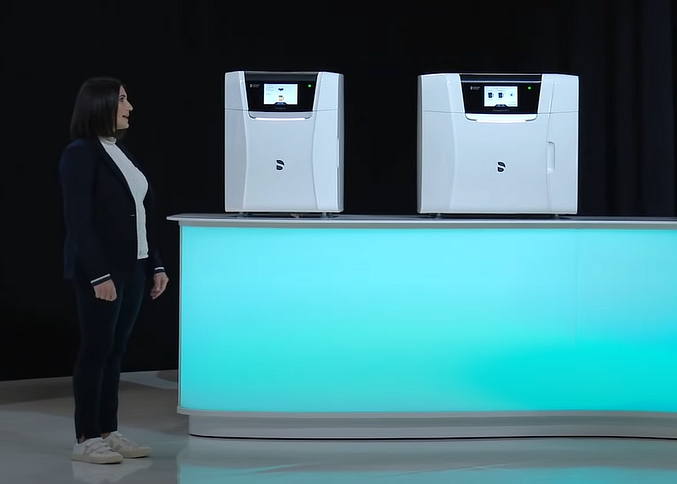Three days ago Dentsply Sirona held an online event called "The Future of Digital Dentistry" (link here for the live stream). This event was a sneak peek into the latest Dentsply Sirona updates, future vision, workflow improvements, and new releases - for both dental labs and clinicians.
Arguably, the biggest announcement of the entire event was the new Dentsply Sirona medical-grade 3D printer built "for the future of digital dentistry" called the Primeprint.
We have taken the liberty to summarize all the information from the event for you below.
Dentsply Sirona announce a Partnership with Google
The Primeprint (and Primeprint Post-Processing Unit)



- 1Prepare the print file
- 2Prepare the Primeprint 3D printer (insert printer cartridges etc)
- 3After printing, move the Primeprint box to the Post-Processing Unit (PPU)
- 4Remove sprues, polish etc.




OK sounds good. But what info is missing from this event?
- 1Price: ?
- 2Print platform size: ? (looks small)
- 3Resolution: ?
- 4Software: ?
- 5Print Speed: ?
- 6Available Resins: ? (closed or open)
- 7Release Date: ?
- 8Accuracy: ?
- 9Printer size: ? (looks big)

An exciting announcement no doubt. A 3D printer being made by the company has been talked about since the CEREC Primescan was released. But are Dentsply Sirona late to the party?
There has been a lot of contention online about this product. For one, it looks huge. But we must not forget that the Primeprint system includes a fully automated wash and processing unit. Dentsply Sirona KOL Dr. Skramstad shared these images about a size comparison:


The other areas of concern that have been voiced is the fact that the build platform looks small and Primeprint seems to use self-contained resins. These have many advantages but also seems to be a closed system. Is this printer closed off to all the other (popular) third party resins? In saying that, what if you no longer need third party resins, with Dentsply Sirona releasing materials for every indication you need?
The fact the system is heavily automated provides countless advantages for ease of use and efficiency, however, how easy is it to troubleshoot when things go wrong? With so many moving parts (robotic arms etc) there may be a higher risk for things to break.
Also quite interestingly, the company didn't mention anything about price. This may make or break the success of the printer in the market. You can get a whole SprintRay bundle for likely a lot less and have more flexibility.
On one hand, I think this will likely be an expensive product compared to the majority of 3D printers on the market. On the other hand, however, Dentsply Sirona are masters of the digital production workflow and making it easy. Just look at how good their chairside workflow is. This is the reason we personally own five complete CEREC systems (5 scanners + 5 mills). The system just works with minimal effort. To the point that the inflated costs of the CEREC scanners (compared to other cheap scanners on the market now) are completely justified.
It will be interesting to see how the Primeprint system finds its footing in the market. Dentsply Sirona enjoy some of the most loyal customers in the entire industry, regardless of price. In saying that we have seen other large dental companies like Planmeca and Ivoclar release printers with little success.
Will Primeprint find success? Leave your comments and thoughts below!

